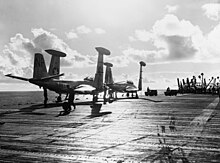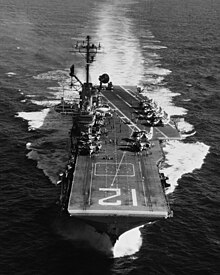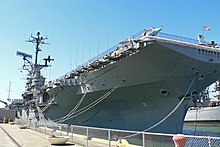USS Hornet (CV-12)
 The Hornet off Okinawa on March 27, 1945 |
|
| Overview | |
|---|---|
| Shipyard | |
| Keel laying | August 3, 1942 |
| Launch | August 30, 1943 |
| 1. Period of service |
|
| period of service |
November 29, 1943 - |
| Whereabouts | Museum ship in Alameda |
| Technical specifications | |
| displacement |
27,100 tons |
| length |
265.8 m |
| width |
45 m |
| Draft |
8.8 m |
| crew |
2600 men |
| drive |
150,000 hp |
| speed |
33 knots |
| Range |
16,900 NM at 15 kn |
| Planes |
80-100 |
The USS Hornet (CV-12) is an Essex- class aircraft carrier of the United States Navy . The ship in 1943 was commissioned in honor of the 1942 sunken carrier USS Hornet (CV 8-) as the eighth ship of the Hornet named. The carrier served in World War II , the Korean War and the Vietnam War . It also gained fame as a rescue ship for Apollo 11 and 12 . Retired in 1970, the Hornet is now a museum ship with National Historic Landmark status in Alameda , California .
technology
→ For detailed information on the technology, see the class article under Essex class
The Hornet belonged to the first group of the Essex class, the so-called "short hull" ships. Her hull was 265.8 meters long , the length in the construction waterline was 250.1 meters, the width 28.4 meters. With an empty displacement of 27,100 tn.l. and an operational displacement of 33,000 tn.l. the draft was between 7.0 and 8.7 meters. The flight deck originally had a width of 45.0 meters. During the renovation from 1955 to 1956, the ship was lengthened to 272.6 meters, the flight deck widened to 58.5 meters and equipped with an angled runway. To increase stability, the hull was widened to 30.8 meters at the waterline. The displacement rose to 32,800 tn.l. empty or 44,700 tn.l. loaded, the draft 9.4 meters. The armor on the waterline was 102 mm thick, this was removed during the conversion, on the flight deck the armor plates were 38 mm thick and on the hangar deck 76 mm.
The steam for the four geared turbines to drive the four propellers was generated in eight boilers with a steam temperature of 454 ° C and a pressure of 39 bar. The total power of the drive was 150,000 hp , the maximum speed of the Hornet was 33 knots , the range with the 6,161 tons of fuel on board was between 4,100 nautical miles at maximum speed and 16,900 nautical miles at 15 knots.
Up to 100 aircraft could be carried on board the carrier. During the Second World War, was aboard squadron of Grumman F6F - fighters and Curtiss SB2C - dive bomber . Between 1953 and 1958, Grumman F9F , McDonnell F2H , North American FJ , Douglas AD and North American AJ were stationed on board. After the reclassification on June 27, 1958, the Hornet was used as a submarine fighter carrier . The on-board squadron then consisted of one or two squadrons with Grumman S-2 and a helicopter-equipped submarine squadron with Sikorsky HSS or, from 1962, with Sikorsky SH-3 . There was also a partial squadron with Grumman E-1 early warning aircraft.
The carrier was equipped with twelve 127-mm guns when it was commissioned, eight of which were in four Mark 32 twin towers on the island, the rest in single mounts below the flight deck on the port side. In addition, 32 40-mm Bofors guns were housed in quadruple mounts and 46 light 20-mm Oerlikon automatic cannons . After the Second World War, the barrel armament was greatly reduced, in 1957 the Hornet still had eight 127 mm single guns and six 76 mm quadruple guns, which had replaced the 40 mm guns after the war. The 76 mm guns were removed the following year, the number of 127 mm guns was reduced to just four by 1970.
history
construction
The construction contract for the fourth Essex- class aircraft carrier was awarded to Newport News Shipbuilding in Newport News , Virginia on September 9, 1940 . The carrier was laid down as the USS Kearsarge in memory of the sloop of 1861 on August 3, 1942. After the sinking of the USS Hornet in the Battle of the Santa Cruz Islands on October 26, the leadership of the US Navy decided to baptize the new carrier with the name Hornet . The christening of the ship by Annie Reid Knox, wife of the Minister of the Navy, Frank Knox , and the subsequent launch took place on August 30, 1943, 13 months after the start of construction. After another three months of equipment work, the carrier entered service on November 29, 1943 under the command of Captain Miles M. Browning.
Second World War
After first test drives off the Bermuda Islands , the Hornet ran from Norfolk on February 14, 1944 for the first mission in the Pacific, on March 20, she was affiliated with the Fast Carrier Task Force at Majuro Atoll . In the weeks that followed, the carrier's planes provided support for air strikes on New Guinea and the Caroline Islands . On June 11, the carrier aircraft launched attacks on Tinian and Saipan , and the following day on Guam and Rota . On June 15 and 16, the units stationed on the Hornet launched attacks on Japanese airports on Iwojima and Chichi-jima in order to prevent counter-attacks on the US troops landing on the Mariana Islands. On the afternoon of June 18, the Fast Carrier Task Force formed to intercept the approaching Japanese first mobile fleet, which was heading through the Philippine Sea towards the Mariana Islands.
In the following two days, the Americans sank three Japanese aircraft carriers during the Battle of the Philippine Sea and shot down over 400 Japanese aircraft by June 20. For the next four months, the Hornet operated from Eniwetok , its planes attacking Japanese positions and facilities in Guam , the Bonin Islands , Palau , Okinawa and Taiwan . During the invasion of Leyte on October 20, the planes provided support for the US troops landing on the beaches, and in the following days they flew attacks on Japanese positions and airfields in the hinterland. The Hornet carrier aircraft were also involved in the Battle of Samar .
In the following two months, the carrier then operated in the region around the Philippines, where the aircraft bombed Japanese positions and ships. On December 30, 1944, the Hornet then ran from Ulithi towards the South China Sea , where the air group attacked targets in Taiwan, Indochina and the Pescadores Islands . On the way back to Ulithi, the carrier's aircraft cleared Okinawa on January 22, 1945 for preparation for landing.
On February 10, the Hornet left Ulithi Atoll, its planes attacked Tokyo several times in the following days , and on February 19 and 20 they then supported the US Marines on Iwojima . Until the amphibious landings on Okinawa in April, the planes attacked Tokyo and the surrounding area several times, as well as Okinawa. On April 6, 1945, the aircraft of the Hornet were involved in the sinking of the Yamato . In the following two months the air group switched between targets on Okinawa and in the Tokyo region. On June 4, the Hornet was damaged in a severe typhoon , seven and a half meters of the front flight deck were destroyed by the waves. She then ran via the Philippines to San Francisco, where she arrived on July 7th. The repairs lasted until September 13, after which they returned US soldiers from the Mariana Islands and Hawaii to the United States as part of Operation Magic Carpet . On February 9, 1946, the Hornet returned to San Francisco, where it remained in port until it was decommissioned on January 15, 1947. After the decommissioning, the carrier was assigned to the reserve fleet.
Modernizations
The Hornet was put back into service on March 20, 1951 and left San Francisco for New York City , where it was decommissioned again on May 12 in the New York Naval Shipyard and went to dock for renovation work. After the completion of the SCB-27A conversion to an attack vehicle and the reclassification to CVA-12, the Hornet resumed service on September 11, 1953, she ran out for the first exercises in the Caribbean. On May 11, 1954, she left Norfolk for a seven-month circumnavigation of the world, after which she operated in the Atlantic and the Mediterranean. In the summer of 1954, the Hornet was part of the US 7th Fleet in the South China Sea, where its planes shot down two attacking Chinese jets. The carrier completed its circumnavigation on December 10th in the port of San Francisco. In the following months he mostly operated off the US west coast, on May 4, 1955, he left San Diego for the western Pacific to join the 7th US fleet. Hornet's planes covered the evacuation of refugees from communist North Vietnam, after further exercises with the fleet in the Pacific, it returned to San Diego on December 10th. From there she drove to Bremerton, where she was docked in January 1956 in the Puget Sound Navy Yard for the SCB-144 conversion until August 15, 1956. After two further missions in the Western Pacific from January 21, 1957 to July 25 and from January 6, 1958 to July 2, the Hornet went into dock again in Bremerton, this time it was converted into a submarine fighter carrier (CVS-12).
1960s
On April 3, 1959, the Hornet then ran out to Japan for anti-submarine exercises, which lasted until October. In the following years, the porter continued to operate in the western Pacific and participated in exercises off Japan, Okinawa, Vietnam and the Philippines. On August 25, 1966, the Hornet recovered the Apollo capsule from the unmanned AS-202 test flight, which had landed near Wake . On September 8, 1966, she returned to Long Beach , the next deployment in the Western Pacific followed on March 27, 1967. The carrier then operated off the Vietnamese coast as part of the Vietnam War .
The Hornet had its most famous mission at the end of July 1969. On July 24, its helicopters recovered the astronauts of the Apollo 11 mission, who had landed on the moon three days earlier . Astronauts Neil Armstrong , Edwin Aldrin and Michael Collins were isolated in a quarantine container on board. Also at Apollo 12 four months later, the Hornet was the salvage ship that the astronauts Charles Conrad , Richard Gordon and Alan Bean salvaged from the Pacific.
Retirement and whereabouts
The Hornet was decommissioned on June 26, 1970. She was mothballed in the reserve fleet for almost two decades until she was removed from the Naval Vessel Register on July 25, 1989. On December 4, 1991, it received the status of a National Historic Landmark . In April 1993 she was supposed to be sold for scrapping, but was given to a foundation that has made the ship accessible to the public as a museum ship in Alameda since 1998 .
In the 1990s, she was the location of an episode (season 3, episode 1) of the successful US television series JAG .
See also
Additional information
literature
- Lee W. Merideth: Gray Ghost. The Story of the Aircraft Carrier Hornet. Historical Indexes, Sunnyvale CA 2003, ISBN 0-9626237-5-X .
- Stefan Terzibaschitsch : aircraft carrier of the US Navy. 3rd, expanded edition. Bernard and Graefe, Bonn 2001, ISBN 3-7637-6200-0 .
Web links
- USS Hornet Museum (Engl.)
- Pictures of the Hornet at navsource.org (engl.)
- History of Hornet (Engl.)
Individual evidence
- ↑ Terzibaschitsch: aircraft carrier of the US Navy. 2001, p. 335.
- ↑ Terzibaschitsch: aircraft carrier of the US Navy. 2001, p. 367.
- ↑ http://gonavy.jp/CV-CV12f.html
- ↑ Listing of National Historic Landmarks by State: California. National Park Service , accessed July 29, 2019.
Coordinates: 37 ° 46 ′ 21 ″ N , 122 ° 18 ′ 10 ″ W.






